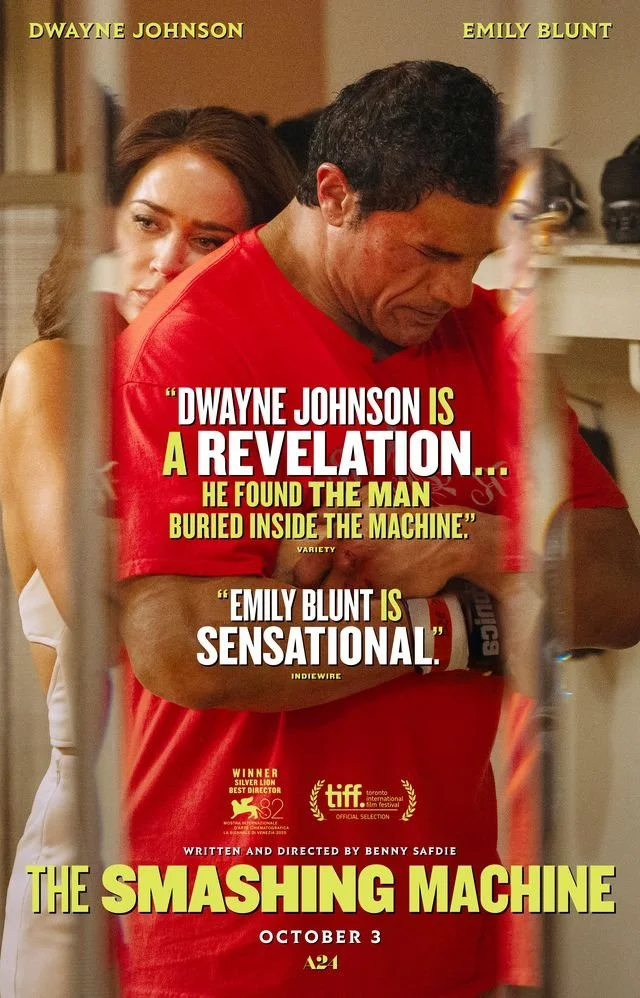'The Smashing Maching' is More of a Doink on The Noggen Than a Knockout
Can you smell The Rock's tears? Since Dwayne Johnson was covering up his face during every crying scene, I can't say that I could. Johnson has transitioned from a blockbuster action star/Baller to an entirely dramatic role that is impressive, but not worth the Oscar buzz the picture is garnering. The Smashing Machine (which inadvertently sounds like a porno) is aesthetically impressive but can't hold a candle to Benny Safdie's previous film, Uncut Gems. The movie has that new inspirational sports story grittiness, where not everything is rose-colored. There's nuance to its characters. Sadly, some of that subtlety gets lost in a picture that lingers on for too long in its brutality and wraps up too quickly with its cheesy finale.
The movie takes place between 1997-2000, then jumps forward a few years. To capture the look of the times, the movie was shot on 16mm film, which was then digitally scanned and projected in IMAX. The look is an interesting hybrid between digital censors and celluloid that feels like you're watching documentary footage from a time period that's now long past us.
The film's sound design is fantastic. Nala Sinephro's score is trippy. It feels like you're listening to Pink Floyd without the vocals while suffering from a pounding headache. It's intended to evoke the perception of physical pain. Hidden beneath the surface of inspiration, the movie doesn't shy away from the barbarity of mixed martial arts. When opponents are beating the tar out of each other, the sound of their bones crunching will make you squirm. It's a no pain, no gain type of mentality that tries to emulate the feeling of being beaten up, yet doesn't really deliver a concise message regarding what the movie is saying about violence. It seems like the movie is trying to make a statement about violence, but in the end, it's clear that it's not, which is odd, given that the movie has a feeling of dread that ultimately ends in optimism.
The aesthetics might be more impressive than Dwayne Johnson's performance. Johnson does a believable job of playing the gentle giant. DJ is known around press circles for being incredibly gracious. Playing the role of a kind-hearted athlete involved in a physically demanding sport isn't too much of a stretch for him. The standout of the film is Emily Blunt, who's a master at hiding her British accent and shedding a tear on command. The two of them bounce off each other well, yet it's Blunt, not Johnson, who has the upper hand in the acting department.
The story itself is a case of the same old tale, yet told in a slightly different way. Real-life UFC fighter Mark Kerr's tale isn't depicted as a rise to fame. He's already a big deal when we meet him after the first scene. A scene that's not believable since some out-of-shape guy takes on The Rock in a small venue. A large portion of the picture focuses on Mark and Dawn's (Emily Blunt) relationship. One that's non-functional. Often, Mark would be preparing for a fight, while Dawn would instigate one due to her own insecurities. The depiction of Dawn is either honest or sexist. Dawn comes off as the stereotypical gold digger who's never satisfied with what she has and is overly emotional. Does she truly love Mark, or love what he has?
Mark is portrayed in the film almost like a saint whose flaw is opioid addiction. One aspect of the movie that's appreciative is that Mark doesn't turn into a monster when juiced up. In fact, he's quite pleasant when he's high. Outside of when Dawn intentionally pushes his buttons, causing him to tear up anything made of wood, hence the film’s title. For people who know addicts, the penjulim between decency and cruelty can sway depending on the person. That's something most movies focusing on drugs won't tell you, possibly out of fear that D.A.R.E. will cause a ruckus if any sort of honesty is to be shown.
There's an element of gritty realism that has transitioned modern sports movie tropes. The Smashing Machine is inspirational, yet it's not played like Rocky, despite containing various similar thematic elements. By the time the movie wraps up, it feels more like a recruitment commercial for the UFC than an original story. To make matters worse, the film could have used 20-30 minutes less in the ring. Large chunks of the movie are a huge drag, as we're watching men pummel each other in a vicious blood sport that's glorified yet also slightly criticized.
In one instance, Mark attends a meeting to discuss the rules of an upcoming fight, as Benny Safdie inserts a sly bit of humor, laughing at the UFC's savagery. As disclosed to the fighters, kneeing someone in the head is illegal, but kicking them in the face while they're down is legal. Either way you cut it, fighters are going to suffer from irreparable brain damage.
Although taken with a more subtextual, grounded approach, The Smashing Machine isn't quite a knockout, but more of a soft blow. The acting is effective, the aesthetics are impressive, and the structure is distinct enough for the film to stand out above most dull, formulaic sports flicks. Yet the issue remains that the film is a rushed, overly familiar story.
The final scene of the picture is almost eye-rollingly sentimental. Whatever makes Mark Kerr's story so unique is no more special than any other story about an athlete who's rewarded for their hard work. It's not a win, but more of a draw.
The Smashing Machine is set to release in theaters nationwide on Friday, October 3rd.



